Estimation of Kcb for Irrigated Melon Using NDVI Obtained Through UAV Imaging in the Brazilian Semiarid Region
Abstract
1. Introduction
2. Materials and Methods
3. Results and Discussion
4. Conclusions
Author Contributions
Funding
Institutional Review Board Statement
Informed Consent Statement
Data Availability Statement
Conflicts of Interest
References
- Bausch, W.C.; Neale, C.M.U. Crop coefficients derived from reflected canopy radiation: A concept. Trans. ASAE 1987, 30, 703–0709. [Google Scholar] [CrossRef]
- Campos, I.; Neale, C.M.; Suyker, A.E.; Arkbauer, T.J.; Gonçalves, I.Z. Reflectance-based crop coefficients REDUX: For operational evapotranspiration estimates in the age of high producing hybrid varieties. Agric. Water Manag. 2017, 187, 153. [Google Scholar] [CrossRef]
- Choudhury, B.; Ahmed, N.; Idso, S.; Reginato, R.; Daughtry, C. Relations between evaporation coefficients and vegetation indices studied by model simulations. Remote Sens. Environ. 1994, 50, 1–17. [Google Scholar] [CrossRef]
- Gomes, M.D.d.A. Coeficiente de Cultivo Para a Videira Com Base no Índice de Vegetação Por Diferença Normalizada Obtido Com Uso de VANT. Tese (Doutorado), Agronomia (Irrigação e Drenagem)—FCA. 2019. Available online: http://hdl.handle.net/11449/183600 (accessed on 23 March 2022).
- González Piqueras, J. Evapotranspiración de la Cubierta Vegetal Mediante la Determinación del Coeficiente de Cultivo por Teledetección. Extensión a Escala Regional: Acuífero 08.29 Mancha Oriental; Universitat de València: València, Spain, 2006; p. 337. Available online: http://hdl.handle.net/10550/14928 (accessed on 20 February 2025).
- Drerup, C.M.; Herbet, A.L.; Monk, K.R.; Nechiporuk, A.V. Regulation of mitochondria-dynactin interaction and mitochondrial retrograde transport in axons. Elife 2017, 6, e22234. [Google Scholar] [CrossRef]
- Malakinezhad, H.; Firoozi, F.; Rahimi, K. Estimating crop coefficients for pistachios and grapes using SEBAL and simple reference evapotranspiration methods in the Central basin of Iran. Arab. J. Geosci. 2022, 15, 1572. [Google Scholar] [CrossRef]
- Panme, F.A.; Sethi, L.N. Estimation of Crop Water Requirements and Irrigation Scheduling for Major Crops Grown in India’s North-Eastern Region. Curr. Appl. Sci. Technol. 2023, 23, 10-55003. [Google Scholar] [CrossRef]
- Allen, R.G.; Pereira, L.S.; Raes, D.; Smith, M. Crop Evapotranspiration-Guidelines for Computing Crop Water Requirements; FAO Irrigation and Drainage Paper 56; FAO: Rome, Italy, 1998; Volume 300, p. D05109. [Google Scholar]
- Shao, G.; Han, W.; Zhang, H.; Zhang, L.; Wang, Y.; Zhang, Y. Prediction of maize crop coefficient from UAV multisensor remote sensing using machine learning methods. Agric. Water Manag. 2023, 276, 108064. [Google Scholar] [CrossRef]
- Kaplan, G.; Fine, L.; Lukyanov, V.; Malachy, N.; Tanny, J.; Rozenstein, O. Using Sentinel-1 and Sentinel-2 imagery for estimating cotton crop coefficient, height, and Leaf Area Index. Agric. Water Manag. 2023, 276, 108056. [Google Scholar] [CrossRef]
- Cattani, C.E.V.; Garcia, M.R.; Mercante, E.; Johann, J.A.; Correa, M.M.; Oldoni, L.V. Spectral-temporal characterization of wheat cultivars through NDVI obtained by terrestrial sensors. Rev. Bras. Eng. Agrícola Ambient. 2017, 21, 769–773. [Google Scholar] [CrossRef]
- Arantes, L.T.; Arantes, B.H.T.; Giongo, P.R.; Ceccato, G.Z.; Moraes, V.H.; Saito, Y.K.; Gomes, L.F.; Castro, A.C.O. Comportamento espectral e detecção de laranjeiras (Citrus sinensis l. osbeck) com estresse hídrico, por meio de drone. Rev. Bras. Geogr. Física 2020, 13, 3625–3635. [Google Scholar] [CrossRef]
- Rasmussen, J.; Ntakos, G.; Nielsen, J.; Svensgaard, J.; Poulsen, R.N.; Christen, S. Are vegetation indices derived from consumer-grade cameras mounted on UAVs sufficiently reliable for assessing experimental plots? Eur. J. Agron. 2016, 74, 75–92. [Google Scholar] [CrossRef]
- Al-Bakri, J.T.; D’Urso, G.; Calera, A.; Abdalhaq, E.; Altarawneh, M.; Margane, A. Remote Sensing for Agricultural Water Management in Jordan. Remote Sens. 2022, 15, 235. [Google Scholar] [CrossRef]
- Johnson, L.F.; Herwitz, S.; Dunagan, S.; Lobitz, B.; Sullivan, D.; Slye, R. Collection of ultra high spatial and spectral resolution image data over California vineyards with a small UAV. In Proceedings of the 30th International Symposium on Remote Sensing of Environment, Honolulu, HI, USA, 10–14 November 2003; International Society of Photogrammetry and Remote Sensing: Paris, France, 2003; Volume 20, pp. 845–849. [Google Scholar]
- Mokhtari, A.; Sadeghi, M.; Afrasiabian, Y.; Yu, K. OPTRAM-ET: A novel approach to remote sensing of actual evapotranspiration applied to Sentinel-2 and Landsat-8 observations. Remote Sens. Environ. 2023, 286, 113443. [Google Scholar] [CrossRef]
- Parmar, S.H.; Patel, G.R.; Tiwari, M.K. Assessment of Crop Water Requirement of Maize Using Remote Sensing and GIS. Smart Agric. Technol. 2023, 4, 100186. [Google Scholar] [CrossRef]
- Rana, V.K.; Suryanarayana, T.M.V. Evaluation of SAR speckle filter technique for inundation mapping. Remote Sens. Appl. Soc. Environ. 2019, 16, 100271. [Google Scholar] [CrossRef]
- Silva, M.V.; Pandorfi, H.; Jardim, A.M.D.R.F.; de Oliveira-Júnior, J.F.; da Divincula, J.S.; Giongo, P.R.; Lopes, P.M.O. Spatial modeling of rainfall patterns and groundwater on the coast of northeastern Brazil. Urban Clim. 2021, 38, 100911. [Google Scholar] [CrossRef]
- Giongo, P.R.; Orlandini, J.D.; Arantes, B.H.T.; Gomes, L.F.; Moraes, V.H.; Costa ARda Ribon, A.A. Predição de dados agronômicos em goiabeiras e separação de alvos por meio de Veículo Aéreo Não Tripulado. Sci. Plena 2020, 16, 040202. [Google Scholar] [CrossRef]
- Giongo, P.R.; de Morais, K.C.B.; da Silva, M.V.; Santos, A.J.M.; Backes, C.; Ribon, A.A.; Pandorfi, H. Chemical and granulometric characterization of soil and its influence on the bromatologic composition of pastures in savannah region, Central Brazil. J. S. Am. Earth Sci. 2022, 114, 103703. [Google Scholar] [CrossRef]
- Oliveira, M.E.G.; da Silva, M.V.; de Almeida, G.L.P.; Pandorfi, H.; Lopes, P.M.O.; Manrique, D.R.C.; de Oliveira-Júnior, J.F. Investigation of pre and post environmental impact of the lockdown (COVID-19) on the water quality of the Capibaribe and Tejipió rivers, Recife metropolitan region, Brazil. J. S. Am. Earth Sci. 2022, 118, 103965. [Google Scholar] [CrossRef]
- Zhang, Y.; Han, W.; Zhang, H.; Niu, X.; Shao, G. Evaluating maize evapotranspiration using high-resolution UAV-based imagery and FAO-56 dual crop coefficient approach. Agric. Water Manag. 2023, 275, 108004. [Google Scholar] [CrossRef]
- Alface, A.B.; Pereira, S.B.; Filgueiras, R.; Cunha, F.F. Sugarcane spatial-temporal monitoring and crop coefficient estimation through NDVI. Rev. Bras. Eng. Agrícola Ambient. 2019, 23, 330–335. [Google Scholar] [CrossRef]
- Perry, E.; Sheffield, K.; Crawford, D.; Akpa, S.; Clancy, A.; Clark, R. Spatial and temporal biomass and growth for grain crops using NDVI Time Series. Remote Sens. 2022, 14, 3071. [Google Scholar] [CrossRef]
- Beck, H.E.; Zimmermann, N.E.; McVicar, T.R.; Vergopolan, N.; Berg, A.; Wood, E.F. Present and future Köppen-Geiger climate classification maps at 1-km resolution. Sci. Data 2018, 5, 180214. [Google Scholar] [CrossRef] [PubMed]
- Hargreaves, G.H.; Samani, Z.A. Reference crop evapotranspiration from temperature. Appl. Eng. Agric. 1985, 1, 96–99. [Google Scholar] [CrossRef]
- Stetson, L.E.; Mecham, B.Q. Irrigation, 6th ed.; Irrigation Association: Fairfax, VA, USA, 2011; pp. 495–546. [Google Scholar]
- EMBRAPA. Sistema de Produção do Melão. Available online: http://sistemasdeproducao.cnptia.embrapa.br (accessed on 20 February 2025).
- Allen, R.G.; Pereira, L.S.; Raes, D.; Smith, M. Evapotranspiration del Cultivo: Guias Para la Determinación de los Requerimientos de Agua de Los Cultivos; Estudio Riego e Drenaje Paper; FAO: Rome, Italy, 2006; n56; p. 298. Available online: http://www.fao.org/docrep/009/x0490s/x0490s00.htm (accessed on 22 February 2022).
- Team, R. Core R: A Language and Environment for Statistical Computing; R Foundation for Statistical Computing: Vienna, Austria, 2022; Available online: https://www.R-project.org/ (accessed on 10 July 2022).
- Rouse, J., Jr.; Haas, R.; Schell, J.; Deering, D. Monitoring Vegetation Systems in the Great Plains with ERTS. NASA Special Publication, 351, 309, 1974. Available online: https://ntrs.nasa.gov/api/citations/19740022614/downloads/19740022614.pdf?utm_source (accessed on 22 February 2022).
- Liaw, A.; Wiener, M. Classification and Regression by random Forest. R News 2002, 2, 18–22. [Google Scholar]
- Gislason, P.O.; Benediktsson, J.A.; Sveinsson, J.R. Random Forests for land cover classification. Pattern Recognit. Lett. 2006, 27, 294–300. [Google Scholar] [CrossRef]
- Congalton, R.G.; Green, K. Assessing the accuracy of remotely sensed data. Biom. JSTOR 1977, 33, 159–174. [Google Scholar]
- Cohen, J.A. Coefficient of agreement for nominal scales. Educ. Psychol. Meas. 1960, 20, 37–46. [Google Scholar] [CrossRef]
- Landis, R.; Koch, G.G. The measurement of observer agreement for categorical data: Principles and Practices. Biometrics 1977, 33, 159–174. [Google Scholar] [CrossRef] [PubMed]
- Maia, C.E.; Silva Neto, J.M.; Braga, A.Q.C. Estimativa da área foliar do meloeiro irrigado em função do número de folhas. Rev. Ibero Am. Ciências Ambient. 2020, 11, 85–91. [Google Scholar] [CrossRef]
- Roessler, E.B.; Pangborn, R.M.; Sidel, J.L.; Stone, H. Expanded statistical tables for estimating significance in paired—Preference, paired–difference, duo–trio and triangle tests. J. Food Sci. 1978, 43, 940–943. [Google Scholar] [CrossRef]
- Iqbal, M. An Introduction to Solar Radiation; Academic Press: New York, NY, USA, 1983; p. 387. Available online: https://books.google.com.br/books?id=3_qWce_mbPsCandlpg=PP1andots=h6vZZrJ2Pqanddq=An%20Introduction%20to%20Solar%20Radiation%20andlrandhl=pt-BRandpg=PR7#v=onepageandq=An%20Introduction%20to%20Solar%20Radiationandf=false (accessed on 20 February 2025).
- Jamieson, P.D.; Porter, J.R.; Wilson, D.R. A test of the computer simulation model ARC—WHEAT1 on wheat crops grown in New Zealand. Field Crops Res. 1991, 27, 337–350. [Google Scholar] [CrossRef]
- Heinemann, A.B.; Van Oort, P.A.; Fernandes, D.S.; Maia, A.D.H.N. Sensitivity of APSIM/ORYZA model due to estimation errors in solar radiation. Bragantia 2012, 71, 572–582. [Google Scholar] [CrossRef]
- Willmott, C.J.; Ackleson, S.G.; Davis, R.E.; Feddema, J.J.; Klink, K.M.; Legates, D.R.; O’Donnell, J.; Rowe, C.M. Statistics for the evaluation and comparison of models. J. Geophys. Res. Ocean. 1985, 90, 8995–9005. [Google Scholar] [CrossRef]
- Camargo, A.P.; Sentelhas, P.C. Avaliação do desempenho de diferentes métodos de estimativa da evapotranspiração potencial no estado de São Paulo. Rev. Bras. Agrometeorol. Santa Maria 1997, 5, 89–97. [Google Scholar]
- Foody, G.M. Explaining the unsuitability of the kappa coefficient in the assessment and comparison of the accuracy of thematic maps obtained by image classification. Remote Sens. Environ. 2020, 239, 111630. [Google Scholar] [CrossRef]
- Phan, T.N.; Kuch, V.; Lehnert, L.W. Land cover classification using Google Earth Engine and random forest classifier—The role of image composition. Remote Sens. 2020, 12, 2411. [Google Scholar] [CrossRef]
- Zhang, L.; Liu, Z.; Ren, T.; Liu, D.; Ma, Z.; Tong, L.; Li, S. Identification of seed maize fields with high spatial resolution and multiple spectral remote sensing using random forest classifier. Remote Sens. 2020, 12, 362. [Google Scholar] [CrossRef]
- Collins, L.; McCarthy, G.; Mellor, A.; Newell, G.; Smith, L. Training data requirements for fire severity mapping using Landsat imagery and random forest. Remote Sens. Environ. 2020, 245, 111839. [Google Scholar] [CrossRef]
- Oliveira, R.M.D.; Cunha, F.F.D.; Silva, G.H.D.; Andrade, L.M.; Morais, C.V.D.; Ferreira, P.M.O.; Oliveira, R.A.D. Evapotranspiration and crop coefficients of Italian zucchini cultivated with recycled paper as mulch. PLoS ONE 2020, 15, e0232554. [Google Scholar] [CrossRef]
- Hernández, E.I.; Encarni, I.; Pastor-Melendez, I.; Gomez, I. Spectral indices for the detection of salinity effects in melon plants. Sci. Agric. 2014, 71, 4324–4330. [Google Scholar] [CrossRef]
- Bergamaschi, H.; Bergonci, J.I. As Plantas e o Clima: Princípios e Aplicações; Agrolivros: Guaíba, Brazil, 2017; 352p. [Google Scholar]
- Kamble, B.; Kilic, A.; Hubbard, K. Estimating crop coefficients using remote sensing-based vegetation index. Remote Sens. 2013, 4, 1588–1602. [Google Scholar] [CrossRef]
- Tefera, A.T.; Banerjee, B.P.; Pandey, B.R.; James, L.; Puri, R.R.; Cooray, O.; Rosewarne, G.M. Estimating early season growth and biomass of field pea for selection of divergent ideotypes using proximal sensing. Field Crops Res. 2022, 277, 108407. [Google Scholar] [CrossRef]
- Draper, N.; Smith, H. Applied Regression Analysis, 3rd ed.; John Wiley and Sons: Hoboken, NJ, USA, 1998. [Google Scholar]
- Pereira, L.S.; Perrier, A.; Allen, R.G.; Alves, I. Evapotranspiration: Concepts and future trends. J. Irrig. Drain. Eng. 1999, 125, 45–51. [Google Scholar] [CrossRef]
- Oliveira, L.E.M.; Mesquita, A.C.; Freitas, R.B. Análise de Crescimento de Plantas; Universidade Federal de Lavras: Lavras, Brazil, 2002; 9p, Available online: http://www.dbi.ufla.br/Fvegetal/Analise%20Crescimento.pdf (accessed on 8 November 2011).
- Dong, T.; Liu, J.; Shang, J.; Qian, B.; Ma, B.; Kovacs, J.M.; Shi, Y. Assessment of red-edge vegetation indices for crop leaf area index estimation. Remote Sens. Environ. 2019, 222, 133–143. [Google Scholar] [CrossRef]
- Berger, R.; Silva, J.A.A.D.; Ferreira, R.L.C.; Candeias, A.L.B.; Rubilar, R. Índices de vegetação para a estimativa do índice de área foliar em plantios clonais de Eucalyptus saligna Smith. Ciência Florest. 2019, 29, 885–899. [Google Scholar] [CrossRef]
- Solís-Silvan, R.; Sanchez-Gutiérrez, F.; Islas-Jesús, R.E.; del Carmen Gerónimo-Torres, J.; Pozo-Santiago, C.O.; Sanchez-Díaz, B. Estimation of the leaf area index from Sentinel images in Eucalyptus grandis W. Hill plantations. Hill plantations. Rev. Tecnol. Marcha 2022, 35, 39–47. [Google Scholar] [CrossRef]
- Towers, P.C.; Strever, A.; Poblete-Echeverría, C. Comparison of vegetation indices for leaf area index estimation in vertical shoot positioned vine canopies with and without grenbiule hail-protection netting. Remote Sens. 2019, 11, 1073. [Google Scholar] [CrossRef]
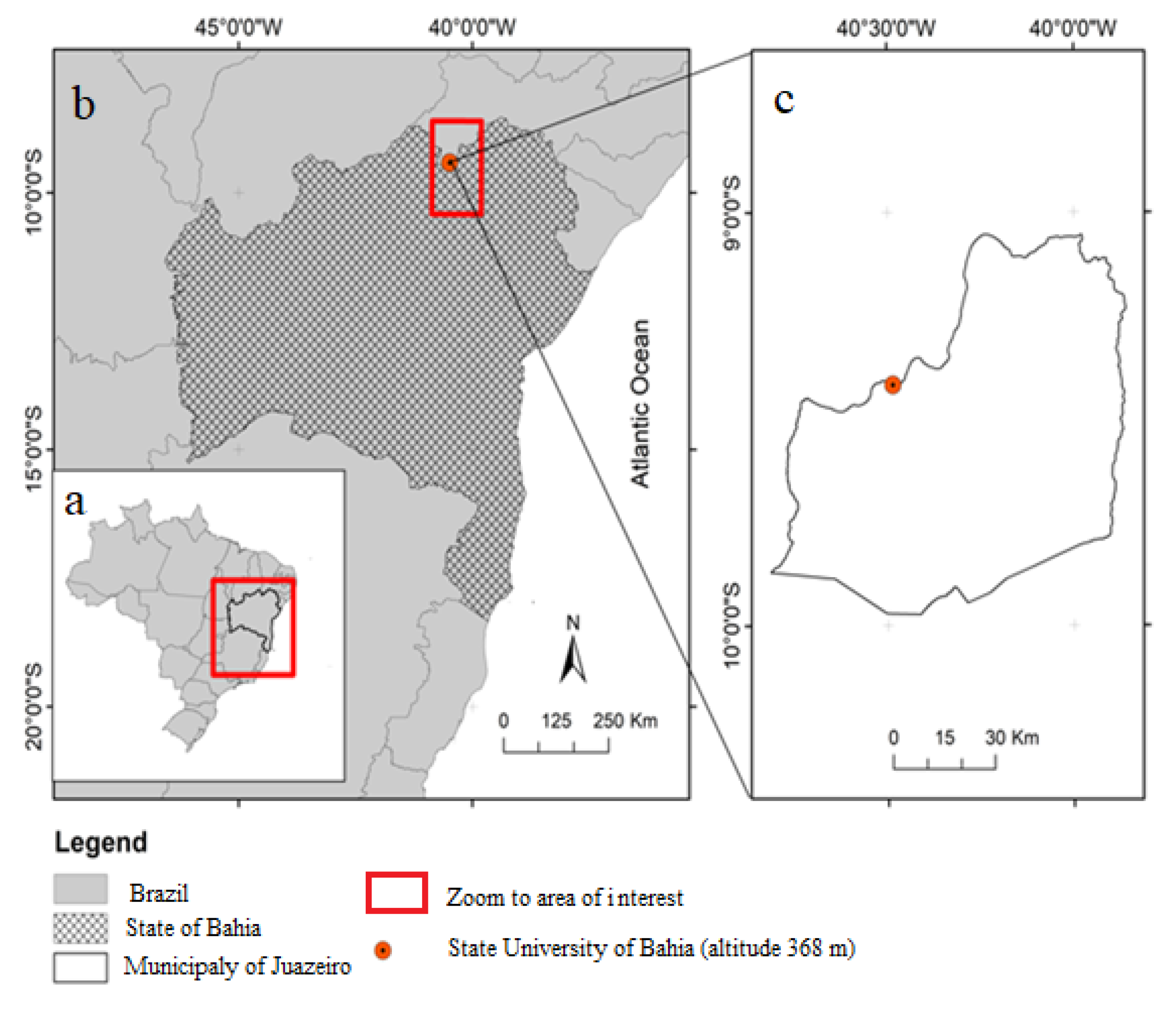
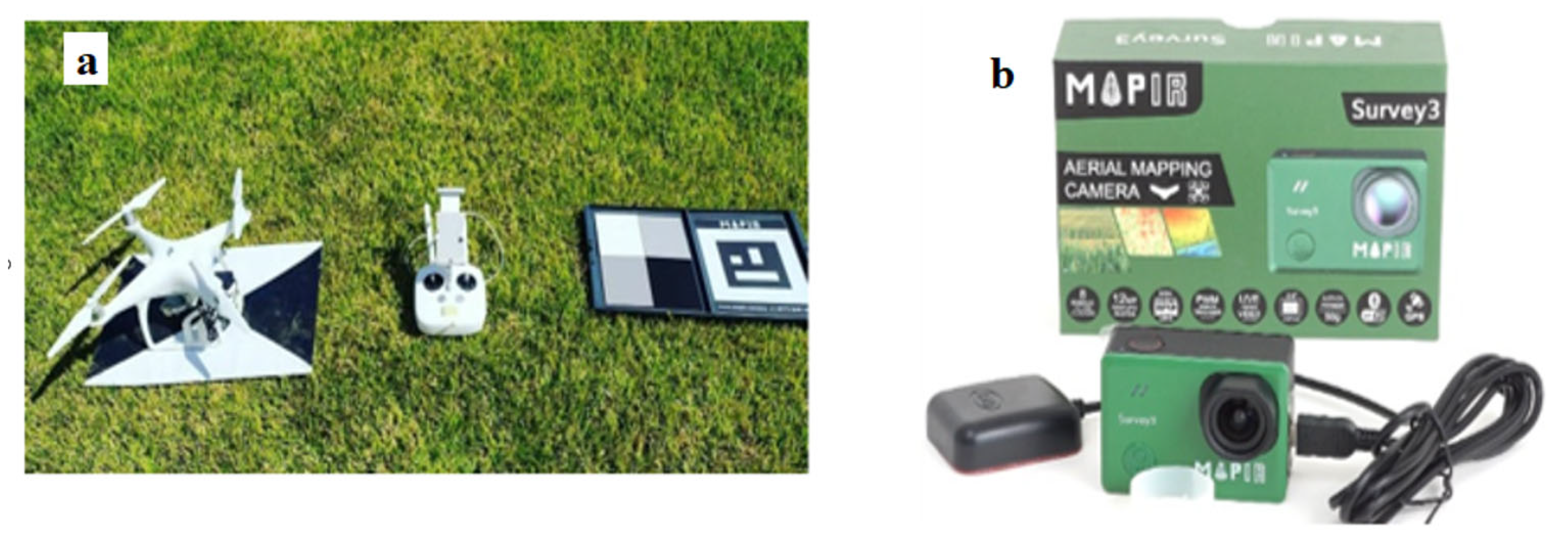
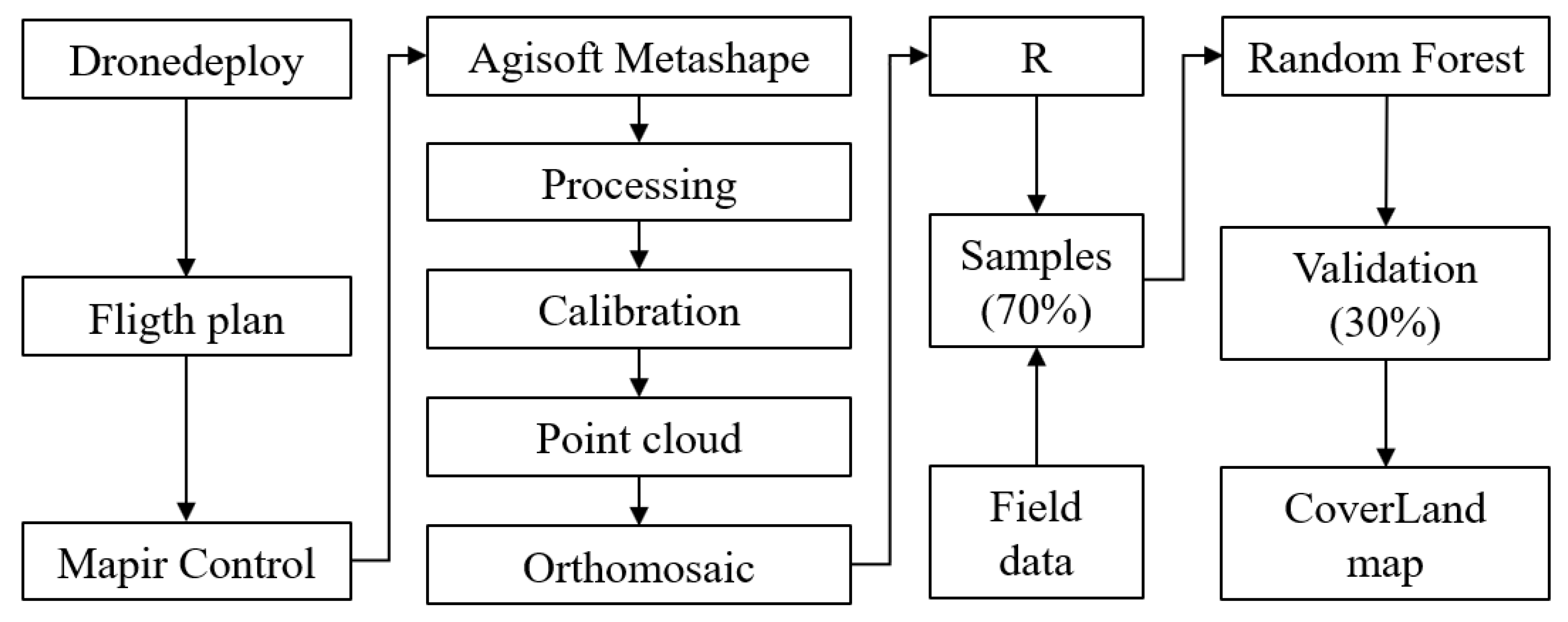

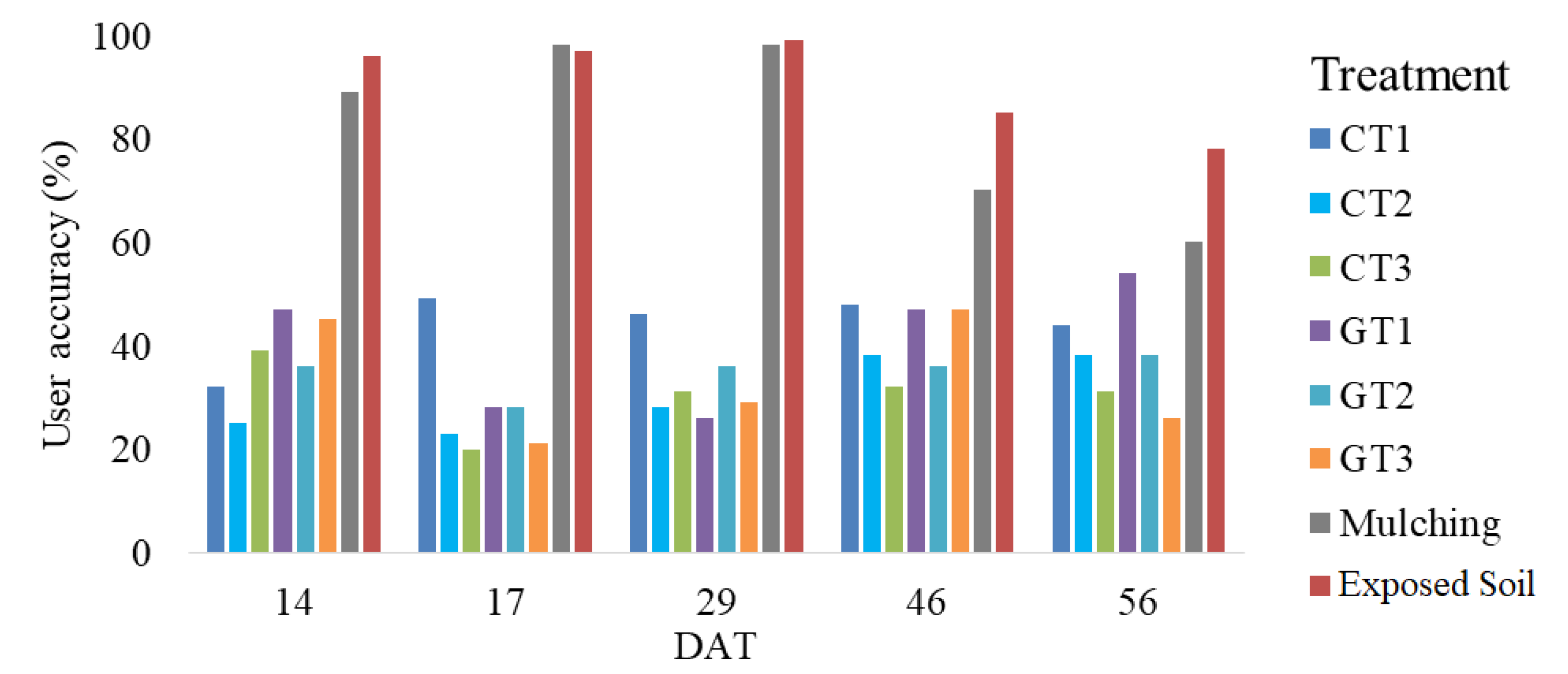


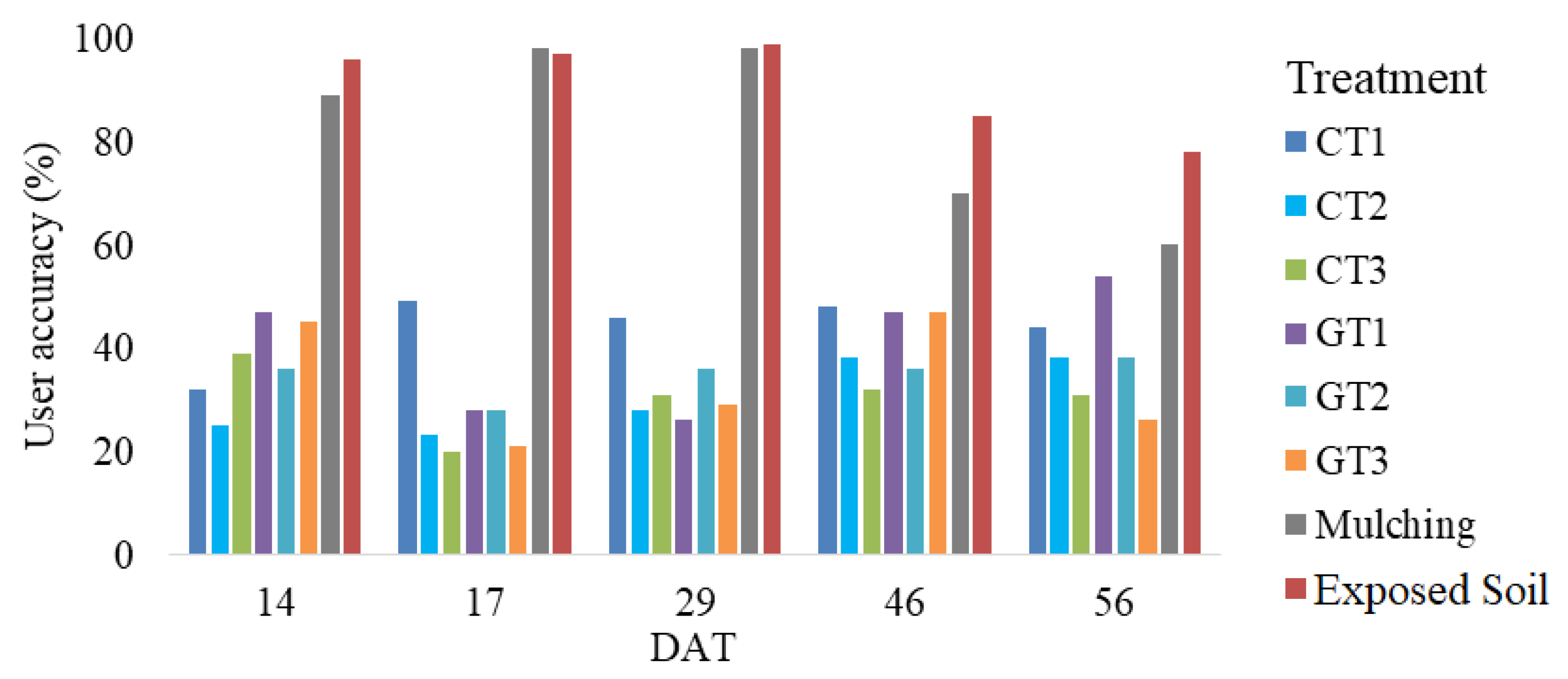
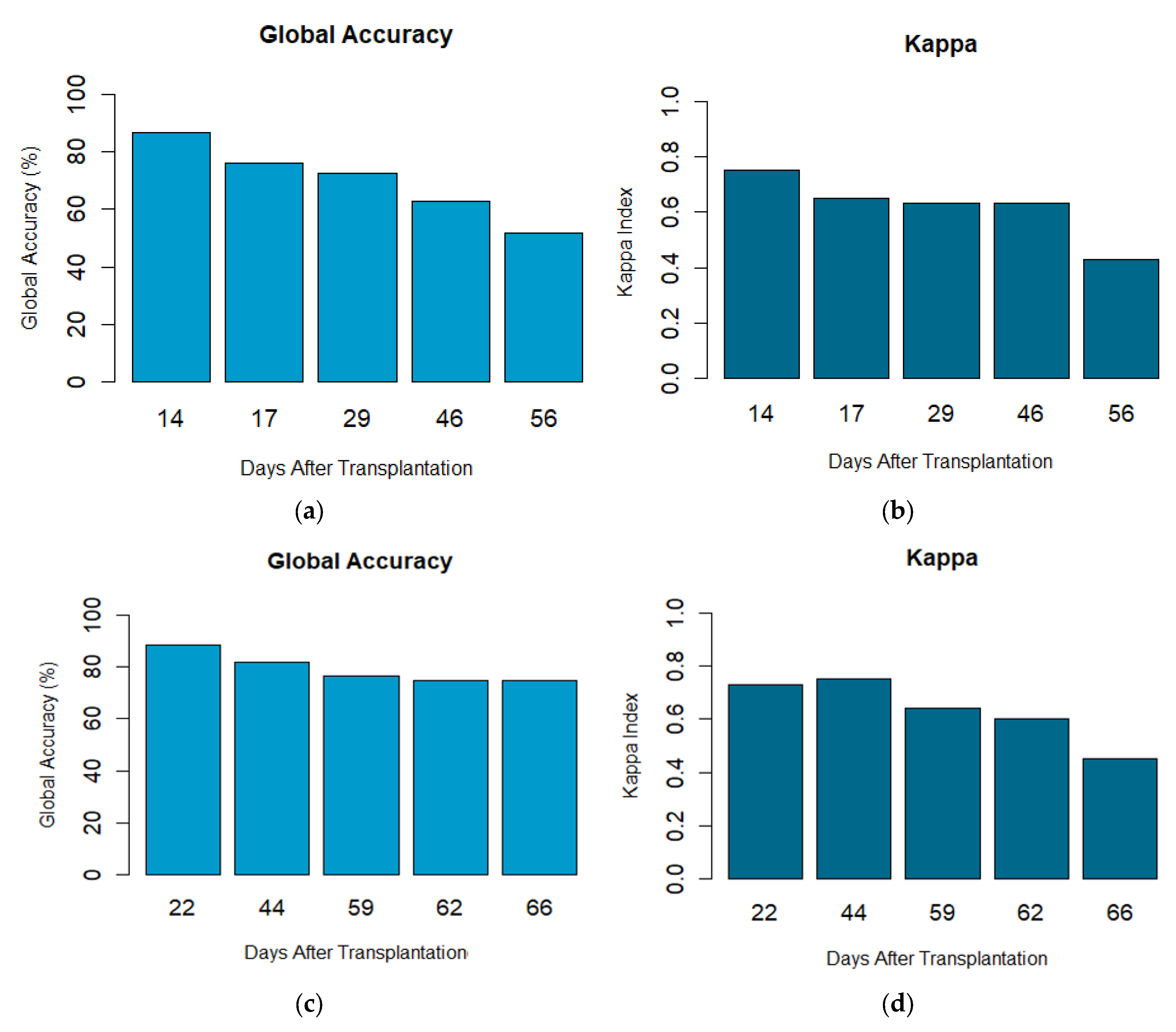
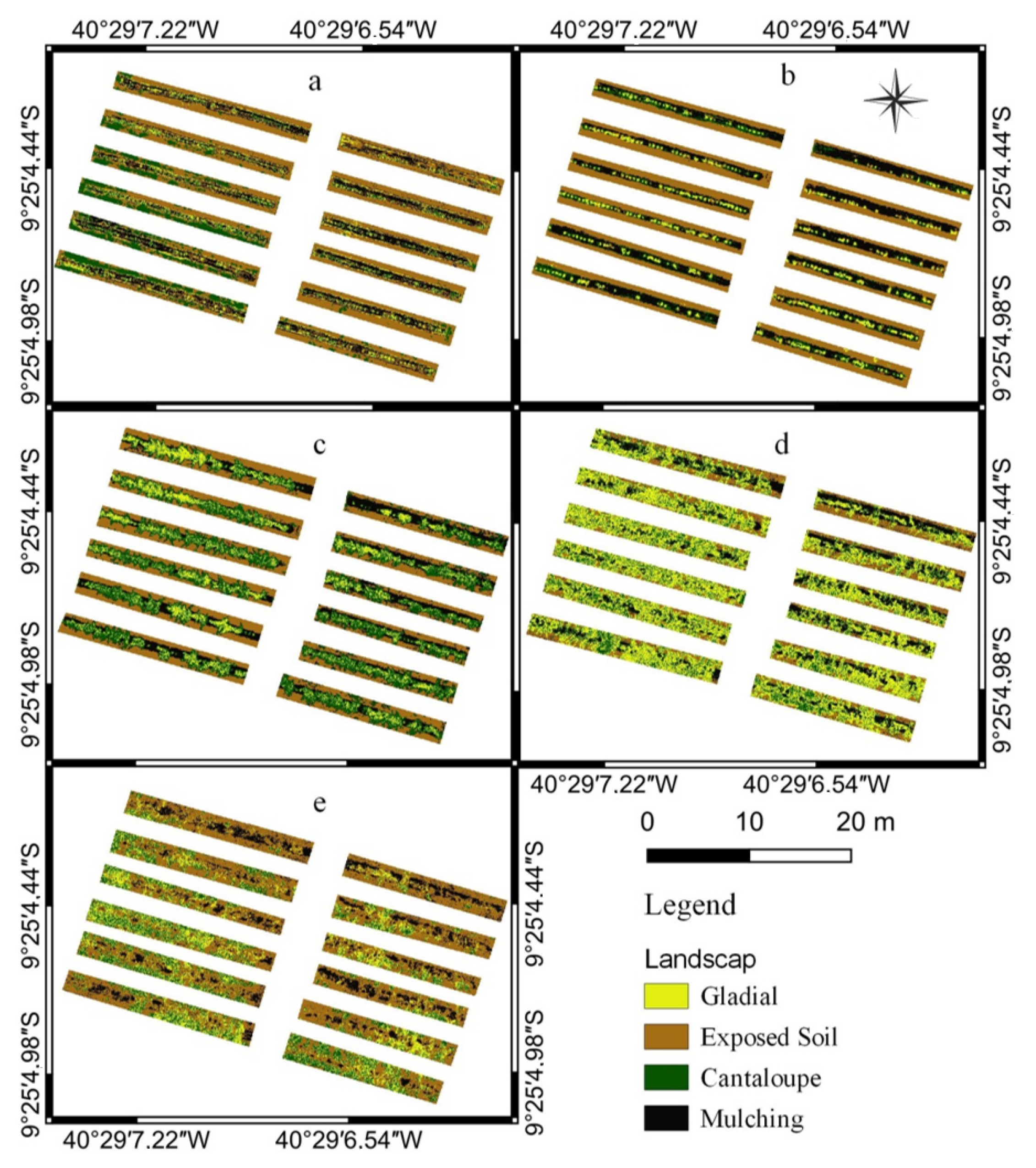



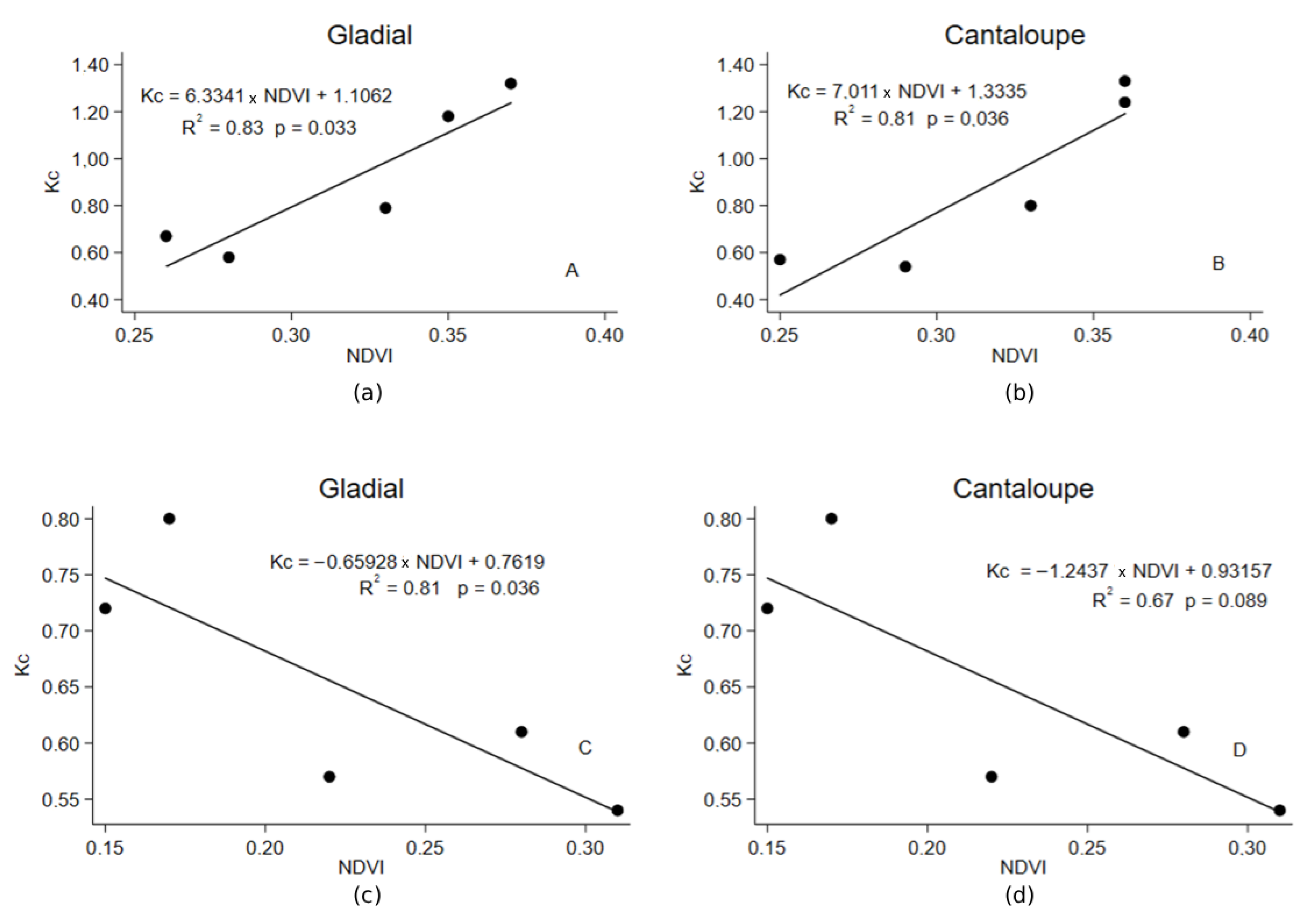

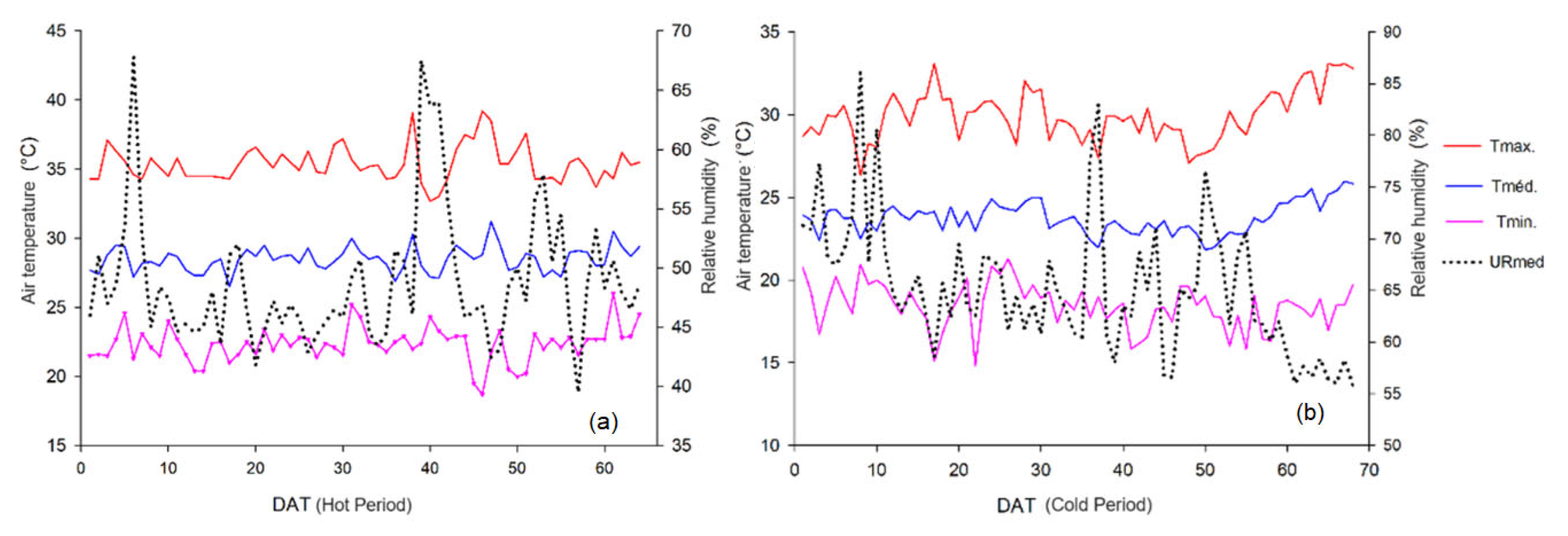

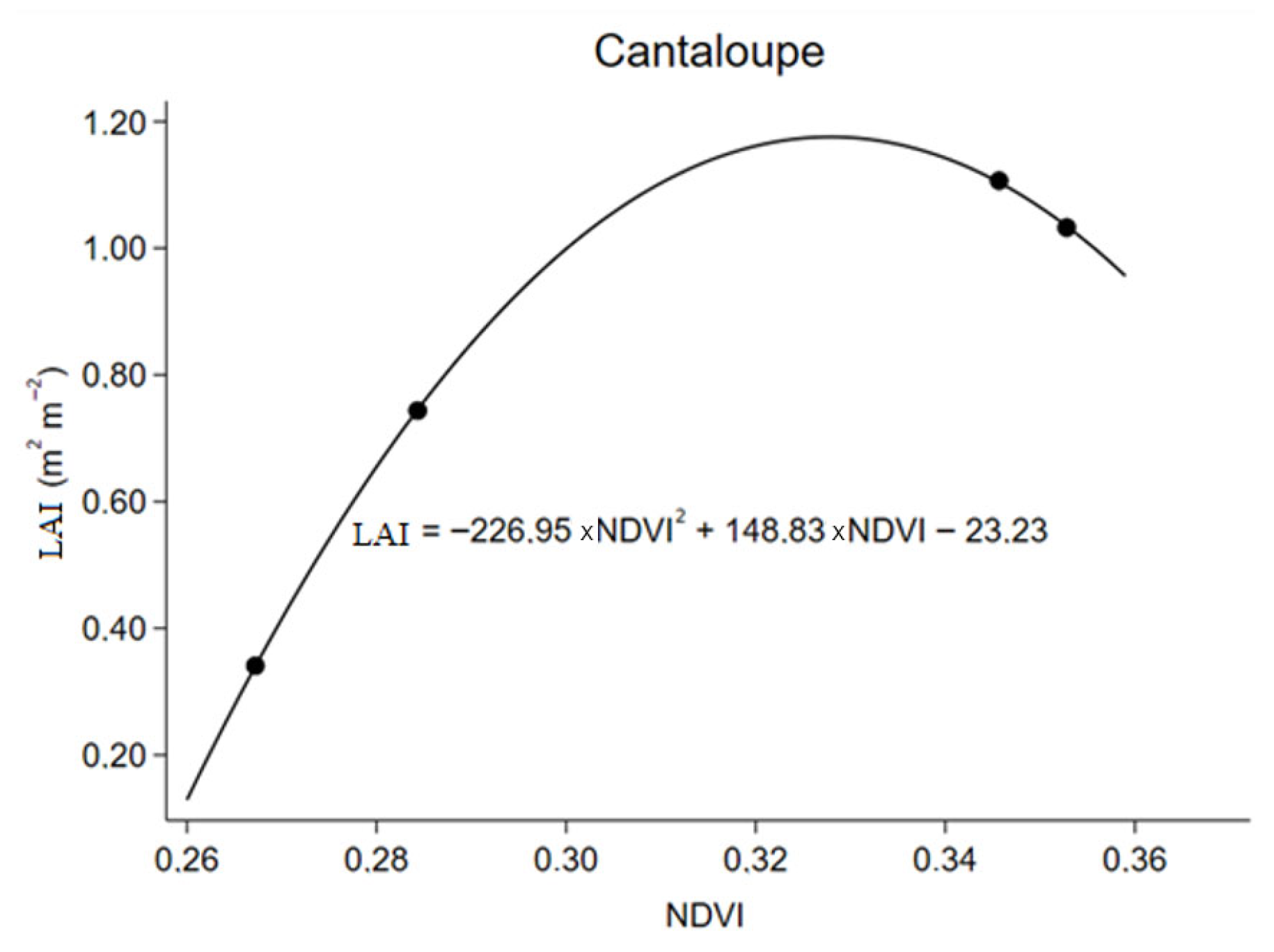
| Hot Period | |||
|---|---|---|---|
| Phenological Stages | Events | Date | DAT |
| I—Initial | Planting | 25 October 2019 | 7 |
| II—Development | 10% ground cover | 13 November 2019 | 19 |
| III—Reproductive | 80% ground cover | 4 December 2019 | 21 |
| IV—Final | Beginning of fruit maturation harvest | 21 December 2019 | 17 |
| Total cycle (days) | — | 64 | |
| Cold Period | |||
| I—Initial | Planting | 26 June 2020 | 9 |
| II—Development | 10% ground cover | 16 June 2020 | 20 |
| III—Reproductive | 80% ground cover | 5 August 2020 | 20 |
| IV—Final | Beginning of fruit maturation harvest | 24 August 2020 | 19 |
| Total cycle (days) | — | 68 | |
| True Class | |||||
|---|---|---|---|---|---|
| j = 1 | … | j = c | Total | ||
| Expected class i | i = 1 | P1,1 | |||
| … | … | Pi,j | … | ||
| i = c | Pc,1 | … | |||
| Total | |||||
| Kappa Values | Interpretation | Rating Quality |
|---|---|---|
| <0.00 | Absence of agreement | Terrible |
| 0.00–0.20 | Poor concordance | Bad |
| 0.20–0.40 | Light concordance | Reasonable |
| 0.40–0.60 | Moderate concordance | Good |
| 0.60–0.80 | Substantive agreement | Very good |
| 0.80–1.00 | Almost perfect concordance | Great |
| Hot Period | |||
|---|---|---|---|
| Flight Day | DAT | NDVI (Average ± sd) | Kc-FAO (Moving Average) |
| 1 November | 14 | 0.26 ± 0.02 | 0.67 |
| 4 November | 17 | 0.28 ± 0.01 | 0.58 |
| 16 November | 29 | 0.33 ± 0.01 | 0.79 |
| 3 December | 46 | 0.37 ± 0.01 | 1.32 |
| 13 December | 56 | 0.35 ± 0.01 | 1.18 |
| Cold period | |||
| 6 July | 22 | 0.09 ± 0.02 | 0.71 |
| 28 July | 44 | 0.08 ± 0.02 | 0.74 |
| 12 August | 59 | 0.27 ± 0.02 | 0.59 |
| 15 August | 62 | 0.18 ± 0.02 | 0.58 |
| 19 August | 66 | 0.35 ± 0.01 | 0.55 |
| Hot Period | |||
|---|---|---|---|
| Flight Day | DAT | NDVI (Average ± sd) | Kc-FAO (Moving Average) |
| 1 November | 14 | 0.25 ± 0.02 | 0.57 |
| 4 November | 17 | 0.29 ± 0.02 | 0.54 |
| 16 November | 29 | 0.33 ± 0.01 | 0.80 |
| 3 December | 46 | 0.36 ± 0.01 | 1.33 |
| 13 December | 56 | 0.36 ± 0.02 | 1.24 |
| Cold period | |||
| 6 July | 22 | 0.15 ± 0.02 | 0.73 |
| 28 July | 44 | 0.17 ± 0.02 | 0.76 |
| 12 August | 59 | 0.28 ± 0.02 | 0.63 |
| 15 August | 62 | 0.22 ± 0.02 | 0.52 |
| 19 August | 66 | 0.31 ± 0.02 | 0.60 |
| Statistical Indicators | Hot Period | Cold Period | ||
|---|---|---|---|---|
| cv. ‘Gladial’ | cv. ‘Cantaloupe’ | cv. ‘Gladial’ | cv. ‘Cantaloupe’ | |
| MAD | 0.11 | 0.14 | 0.03 | 0.05 |
| MSE | 0.00 | 0.00 | 0.00 | 0.00 |
| RMSE | 0.12 | 0.14 | 0.03 | 0.05 |
| rRMSE | 12.00 | 14.00 | 3.00 | 5.00 |
| MAPE | 6.86 | 4.16 | 18.63 | 14.14 |
| R2 | 0.83 | 0.81 | 0.81 | 0.67 |
| r | 0.91 | 0.91 | 0.91 | 0.82 |
| d | 0.92 | 0.90 | 0.89 | 0.85 |
| c | 0.76 | 0.73 | 0.73 | 0.69 |
Disclaimer/Publisher’s Note: The statements, opinions and data contained in all publications are solely those of the individual author(s) and contributor(s) and not of MDPI and/or the editor(s). MDPI and/or the editor(s) disclaim responsibility for any injury to people or property resulting from any ideas, methods, instructions or products referred to in the content. |
© 2025 by the authors. Licensee MDPI, Basel, Switzerland. This article is an open access article distributed under the terms and conditions of the Creative Commons Attribution (CC BY) license (https://creativecommons.org/licenses/by/4.0/).
Share and Cite
Siqueira, J.M.; de Oliveira, G.M.; Giongo, P.R.; Taveira, J.H.d.S.; Santiago, E.J.P.; Leitão, M.d.M.V.B.R.; Marinho, L.B.; Santos, W.M.d.; Jardim, A.M.d.R.F.; Silva, T.G.F.d.; et al. Estimation of Kcb for Irrigated Melon Using NDVI Obtained Through UAV Imaging in the Brazilian Semiarid Region. AgriEngineering 2025, 7, 340. https://doi.org/10.3390/agriengineering7100340
Siqueira JM, de Oliveira GM, Giongo PR, Taveira JHdS, Santiago EJP, Leitão MdMVBR, Marinho LB, Santos WMd, Jardim AMdRF, Silva TGFd, et al. Estimation of Kcb for Irrigated Melon Using NDVI Obtained Through UAV Imaging in the Brazilian Semiarid Region. AgriEngineering. 2025; 7(10):340. https://doi.org/10.3390/agriengineering7100340
Chicago/Turabian StyleSiqueira, Jeones Marinho, Gertrudes Macário de Oliveira, Pedro Rogerio Giongo, Jose Henrique da Silva Taveira, Edgo Jackson Pinto Santiago, Mário de Miranda Vilas Boas Ramos Leitão, Ligia Borges Marinho, Wagner Martins dos Santos, Alexandre Maniçoba da Rosa Ferraz Jardim, Thieres George Freire da Silva, and et al. 2025. "Estimation of Kcb for Irrigated Melon Using NDVI Obtained Through UAV Imaging in the Brazilian Semiarid Region" AgriEngineering 7, no. 10: 340. https://doi.org/10.3390/agriengineering7100340
APA StyleSiqueira, J. M., de Oliveira, G. M., Giongo, P. R., Taveira, J. H. d. S., Santiago, E. J. P., Leitão, M. d. M. V. B. R., Marinho, L. B., Santos, W. M. d., Jardim, A. M. d. R. F., Silva, T. G. F. d., & Silva, M. V. d. (2025). Estimation of Kcb for Irrigated Melon Using NDVI Obtained Through UAV Imaging in the Brazilian Semiarid Region. AgriEngineering, 7(10), 340. https://doi.org/10.3390/agriengineering7100340










